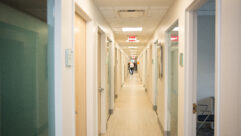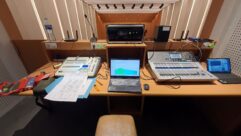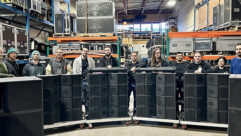Sound Masking Comes Full Circle
Feb 28, 2008 10:28 AM,
By Jessaca Gutierrez
In an age where security and privacy is king—made that way, ironically, from the very technology moving us forward (two steps forward, one step back)—buildings are growing more intelligent in protecting our everyday conversations from outside listeners. What’s more, a growing number of office spaces are based around open plans, separated by little more than cubicle partitions, allowing speech and noise to travel faster and farther, causing a disruption in the environment. To work efficiently means the space needs to be equipped with a sound-masking system that can handle the inherent buzz and hum of the office space, such as printers whirling, phones ringing, and coworkers conversing around the water cooler, which can also add to the audible din.
In the ’80s, sound and video contractors included sound masking in their portfolio of products offered. But because the technology and the education behind correctly designing, installing, and deploying a sound-masking system weren’t fully adopted, sound masking as part of the sound and video contracting industry was left in the dust— left to other contractors to pick up the pieces and turn it around. Since then, the technology and education have taken huge steps, and sound-masking systems are rapidly becoming a cornerstone in commercial office spaces, hospitals, banks, libraries, and many other buildings that require a comfortable and secure environment.
“What’s happened is that [sound masking has] come around full circle because everyone has figured out better ways to do sound masking on so many levels,” says Vice President Jonathan Leonard of Lencore Acoustics, a sound-masking systems provider in the industry. “The technology that we are integrating into our products makes sense for sound and video integrators and contractors to really consider making this part of their portfolio again because the systems that we’ve designed work properly and give integrators and contractors the tools that they need to sell successful and efficient systems. At the same time, these integrators and contractors are the right people in the right channels who will be installing and servicing these types of systems.’ It’s kind of remarkable that it’s come back full circle.”
Sound Masking Comes Full Circle
Feb 28, 2008 10:28 AM,
By Jessaca Gutierrez
But the technology isn’t the only factor in play. Privacy, Leonard says, is really pushing sound-masking industry to the forefront in building design. With government measures such as the more familiar Health Insurance Portability and Accountability Act (HIPAA) to protect individuals healthcare information and the Gramm-Leach-Bliley Act (GBLA), or the Financial Modernization Act of 1999, to protect personal financial information held by financial institutions, many institutions are seeking out sound masking as a way to ensure the oral privacy of their clients and in turn giving the sound-masking industry a boost.
“Basically, the federal law mandates that in a healthcare setting or any setting where you’re transferring personal health information, such as a hospital, human resources areas, medical clinics, or insurance companies, that they must comply with HIPAA regulations,” Leonard says. “So privacy has come to the forefront in the minds of consumers, whether they are a consumer who builds office environment or works in a healthcare environment, the federal laws have really made companies buckle down their approach to protecting privacy. [HIPAA and GBLA] were obvious things that needed to happen because imagine the impact if someone’s financial information or medical records got placed on the Internet, you could never recover that information ever again.
The masking industry has really changed and has challenged companies to create better equipment, and better designs. It’s also been more readily adopted because people want and crave privacy on many levels, from providing a comfortable space in which to work, to building spaces that provide occupants with the ability to be productive, all the while maintaining an appropriate level of privacy.
In response to HIPAA concerns, Leonard has worked with a number of high-profile healthcare clients to meet their compliance objectives, however, widespread adoption of the oral privacy portion of HIPAA has yet to be seen because there’s currently no real pro-active push for compliancy. Until then, Leonard says that many of the facilities that do address HIPAA oral privacy most likely do so because of the economic benefits to their clients.
For example, installing a sound-masking system in patient rooms of a hospital has shown to improve patient satisfaction with their hospital stays and this has been linked to an increase in bed turnover rates. The reasoning: If patients can get better rest—free from the heavy foot traffic and noise prevalent in hospitals—they can get well faster. If a hospital can be well known for providing a comfortable, restful setting, then more patients will want to use that facility should they have an operation or emergency. Sound masking provides added value.
It isn’t just hospitals and banks taking the opportunity to make their environments more comfortable and secure either. Corporations are also using sound-masking systems in their building so their employees can work undistracted, allowing them to make the most of their time and be more efficient. After all, who wants an underperforming employee?
Sound Masking Comes Full Circle
Feb 28, 2008 10:28 AM,
By Jessaca Gutierrez
Why Technology?
With all the buzz about IT and AV convergence, it’s easy to get caught up in the systems making the AV industry grow, which is something Leonard says integrators have to watch out for. Instead, it’s essential to get back to the roots of what it means to be a part of this industry. “The most important element of sound masking is actually the sound that is created in the system and how it is propagated,” Leonard says. “That needs to be looked at first because too often companies do a great job of selling ‘why’ technology—I call it why technology because why do you need it? If it doesn’t really lend to any purpose that’s significant in improving the quality of either the masking system or the space, what is its purpose? That is why it is most important to always start with the sound.”
DSP technology in masking systems is really raising the bar. Because the mind thinks best with a mix of non-congruent sound, DSPs are a great tool as the sound-generating source of a sound-masking system. Leonard says you can look to nature to find the type of sound that creates a comfortable environment, such as waves at the beach or wind rustling the leaves on the trees. “Our brains enjoy complete random sounds that have many different sources,” Leonard says. “It’s important that when we create our masking sound that we create as many sound sources as possible—the DSP is a great device to help us do that.”
Working with Architects
Because more AV systems are becoming part of design builds, architects are slowly reaching out to integrators to deploy systems that are tied into the building’s IT backbone. This is opening up the communication lines between architects, integrators, and even building owners. But the relationship between architects and integrators still leaves much to be desired. Leonard says that although more integrators are becoming a resource to architects, education has to happen on both sides for sound-masking to recognize its full potential. Often, it is facility managers and building owners pushing architects to put sound-masking systems in their buildings.
“It’s not that [architects] are not concerned with acoustics, they are,” Leonard says. “It’s just that architects will typically get an acoustical engineer involved to handle acoustics, but since everyone should be part of the design and implementation process, we all need to be proactive in understanding how to address the acoustics to create better space. “
Industry associations are working to develop and strengthen the relationship between architects and integrators. Education is slowly happening on both sides. For example, Lencore conducts a sound-masking systems presentation for American Institute of Architects (AIA) credit. InfoComm and NSCA both have offered educational sessions in the past that have addressed sound-masking to support this area of interest.
Where’s sound masking heading and will the future be even brighter for opportunities? Leonard seems to think so: “It’s moving in that very strong, very plodding direction, so eventually a path will be carved, and it will be a pretty deep path—one that will absolutely create opportunity for companies that are in the channel for sound masking.”
In the next issue of Corporate AV, find out the good and the bad of proprietary systems in the AV industry.










